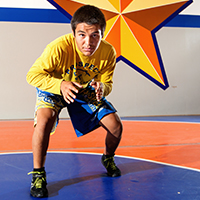Unusual Leg Surgery at Lucile Packard Children’s Hospital Stanford Doesn’t Hold Wrestling Champ Back
Now ready for wrestling season in November
For Release: September 16, 2014
PALO ALTO, Calif. – Sixteen-year-old Alexis Santana of San Jose, Calif., is missing two major muscles in his body – one in his back and one in his leg. But that didn’t seem to matter when he won a California state wrestling championship last year or when he led his high school team to a 2014 league championship.
In fact, Alexis believes the missing muscles, which were surgically removed at Lucile Packard Children’s Hospital Stanford in 2009, may actually have helped him become a more powerful wrestler.
“After the surgery was over, I was more determined than ever to get better at wrestling,” said Alexis.
In his early years, Alexis’ parents and doctors weren’t too concerned about an unusual birthmark on his left leg. As he grew, however, so did the birthmark, which his mother said began to resemble a raised, small bulb of cauliflower.
Doctors initially tried to remove it with laser treatments and local surgery. After each treatment, the growth, which eventually was diagnosed as a verrucous hemangioma – a rare vascular malformation – not only didn’t go away, it came back even bigger and uglier.
By the time he was 11, the disfiguring growth extended from the base of his left knee to the lower part of his leg and deep into his muscles and connective tissue. That’s when Alexis and his parents met with Rohit Khosla, MD, a plastic surgeon at Lucile Packard Children’s Hospital Stanford and Stanford Medicine Children’s Health.

“It was large and expanding,’’ said Khosla, who is also an assistant professor of plastic and reconstructive surgery at the Stanford University School of Medicine. “We had to come up with a more definitive treatment.”
Khosla planned a lengthy and intricate operation that was done in two parts. First, Khosla removed all of the abnormal tissue, skin, muscle and periosteum (covering of the bone) from Alexis’ leg. Once the diseased area had been eliminated, the lower leg had a large hole down to the bone. Khosla filled that hole by taking a significant back muscle – the latissimus – and transferring it into his leg. Moving that muscle to another part of the body is often done in adults when necessary, but is rarely done in children, said Khosla.
“Given the size of the area involved, we needed a very large piece of muscle so we used the latissimus,’’ he said. “It’s completely gone from one side of his back. The latissimus is important in terms of movement of the upper arm and shoulder, but we know that people actually do very well without it.”
Although the latissimus – which is used in activities such as pull-ups, rock climbing and rowing – replaced the diseased leg muscle and surrounding tissue, once it was cut from the back, it no longer served the function of a muscle.
“It was a really tough surgery,’’ said Gerardo Santana, Alexis’s dad. “He had a gash a foot long on his back and another on his leg. He had to lie on his side. He couldn’t move.”
Rehabilitation began slowly. To avoid blood clots in the transferred muscle, Alexis was confined to a wheelchair for a couple of months. With the help of hospital nurses, physical therapists and his family, he slowly trained the newly transferred muscle to handle blood flow and the effects of gravity on the circulation in the tissue. His method? Dangling his leg over the edge of the bed.
Khosla says he always expected Alexis would regain full function of his leg and back – what he didn’t anticipate was that he would become a wrestling champion. Alexis has even bigger hopes. Now a junior in high school, he hopes his wrestling will earn him a scholarship to MIT after graduation in 2016.
“I would have expected him to have led a productive and functional life, but he’s achieving milestones that are even greater,’’ Khosla said. “It’s amazing to see. He’s very strong. He really is a champion.”
The only remnant of the once unsightly growth is a foot-long scar. Initially embarrassed by the mark, Alexis would carefully wrap it during wrestling matches to hide it. But as he regained his strength and footing, his confidence came back, too.
“One day he said, ‘I don’t care what they say about me, I am who I am and I’m not going to cover it anymore,’’’ dad Gerardo Santana recalled. “Now when people ask him what happened, he just tells them he was bitten by a shark.”
Authors
Media Contact:
Robert Dicks
rdicks@stanfordchildrens.org
(650) 497-8364
About Stanford Medicine Children's Health
Stanford Medicine Children’s Health, with Lucile Packard Children’s Hospital Stanford at its center, is the Bay Area’s largest health care system exclusively dedicated to children and expectant mothers. Our network of care includes more than 65 locations across Northern California and more than 85 locations in the U.S. Western region. Along with Stanford Health Care and the Stanford School of Medicine, we are part of Stanford Medicine, an ecosystem harnessing the potential of biomedicine through collaborative research, education, and clinical care to improve health outcomes around the world. We are a nonprofit organization committed to supporting the community through meaningful outreach programs and services and providing necessary medical care to families, regardless of their ability to pay. Discover more at stanfordchildrens.org.
Connect with us:
Download our App: